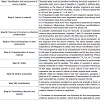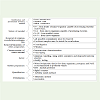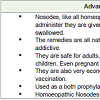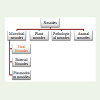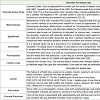Review Article
Viral Nosodes as an Alternative to Vaccination: An Update
Bhargavkumar Patel and Rajashree Mashru*
Quality Assurance Laboratory, Faculty of Pharmacy, Shree G.H. Patel Pharmacy Building, The Maharaja Sayajirao University of Baroda, Fatehgunj, Gujarat, India
Corresponding author: Dr. Rajashree Mashru, Quality Assurance Laboratory, Faculty of Pharmacy, Shree G.H. Patel Pharmacy Building, Donor’s Plaza, The Maharaja Sayajirao University of Baroda, Fatehgunj, Vadodara-390002, Gujarat,India, E-mail: rajshreemashru@yahoo.com
Citation: Patel B, Mashru R. Viral Nosodes as an Alternative to Vaccination: An Update. J Immunol Vaccine Technol. 2017;2(1): 106.
Copyright © 2017 Patel B, et al. This is an open access article distributed under the Creative Commons Attribution License, which permits unrestricted use, distribution, and reproduction in any medium, provided the original work is properly cited.
Journal of Immunology and Vaccine Technology | Volume: 2, Issue: 1
Submission: 06/04/2017; Accepted: 04/05/2017; Published: 09/05/2017
Abstract
Nosodes are homeopathic preparations of organic materials made from inactivated disease products, cultures of microorganisms (e.g. bacteria, fungi, and viruses) or parasites, infected or pathologically altered material or decomposition products from humans or animals, rendered safe during the homeopathic manufacturing process. It is now taken as an alternative to all other therapies owing to its advantages like efficiency in diphtheria, hepatitis, parvovirus infection in dogs, rabies, gonorrhea, polio, syphilis, varicella zoster, and variolinum infection in dogs as medicines well. Nosodes today, are considered as a vital and essential part of therapy. Nosodes can be classified according to sources from which it is being prepared. It has a tremendous use in therapy with certain limitations. The nosodes comprise of less than about 4% of all homeopathic medicines listed in homeopathic pharmacopeia. Nosodes are not a routine prescription (prescribed infrequently) and are largely prescribed for chronic conditions. Use of nosodes and sarcodes in the treatment of disease conditions is known as biotherapy or immunotherapy or organopathy or homeoprophylaxis.
Keywords: Nosodes; Vaccination; Viral safety
Introduction
The Greek prefix “noso” means disease, thus indicating the pathological root of nosodes. This term is also connected with the Latin word “noxa”, related to noxious or damaging, which implies the use of noxious materials as a basis for a homeopathic remedy [1],2].
Nosodes are highly diluted homeopathic preparations sourced from biological materials such as diseased tissues, organisms, cultures (bacteria, fungi, and viruses), or parasites, or from decomposed products from humans or animals. In homeopathic practices, more than 45 major nosodes have been in use since 1830 [3,4]. Though clinical benefits of nosodes have often been experienced by homeopathic practitioners and patients, very few have so far been scientifically tested for their anticipated effects, particularly in vitro [5-7]. Nosodes came into use since the earliest experiments by Constantine Hering while he was in South America between 1827 and 1833. In one of the studies Joshi et al. developed a method for preparation and standardization of univalent and polyvalent Mycobacterium nosodes (labeled as Emtact), using different strains of Mycobacterium tuberculosis [8]. The homeopathic nosodes can be used for treating residual infections (e.g. bacillinum for tuberculosis) and as a prophylactic (e.g. Influenzium for swine flu) whereas sarcodes are used to help rebuild organs and tissue that may be diseased or malfunctioning (e.g. lymph, spleen) [9]. Nosodes have been explored and experimented with many from time to time, but because of the nature of their starting materials, they have been frequently scrutinized for safety and efficacy. There are approximately 150 nosodes mentioned in the homeopathic literature, but very few are part of official homeopathic pharmacopoeias [10]. Nosodes can be used in the same way as vaccines, that is, to prevent viral infection. Like vaccines, nosodes sensitize the body to a particular virus, as a result, the immune system responds instinctively and effectively to natural response. Nosodes, in some cases, have been shown to be significantly more effective than vaccines in preventing infection. The advantage of nosodes over vaccines is the fact that they are completely safe and they can also be safely administered to puppies and kittens much earlier than vaccines. Nosodes, like others homeopathic remedies, are very easy to administer: they are given by mouth and don’t even need to be swallowed [11,12]. Christopher Day, Veterinarian and former Chairman of the International Association for Veterinary Homeopathy (IAVH) have gained extensive experience with the use of nosodes in herds of food producing animals [13,14]. Nosodes are successful in the treatment of severe and economically relevant health problems in these animals. “Nosodes are an essential component of natural products for farm livestock. The European consumer is right in demanding an ever decreasing reliance on conventional drug intake for food animals. Natural products represent the only way forward to satisfy this demand in order to maintain or enhance the health of the animals. Infectious diseases such as mastitis in many herds can only be treated using nosodes. The loss of nosodes for the homeopathic treatment approach would be a serious animal welfare issue” [15]. Homeoprophylaxis (HP) is the use of homeopathically prepared substances to prevent targeted infectious diseases in recipients. Its first use in an epidemic of Scarlet Fever was documented in 1801. It has been used throughout the world since then for both short-term and long-term preventative purposes. The effectiveness and safety of Golden’s long-term HP program using homeopathically prepared substances to prevent targeted infectious diseases in recipients were tested through two research projects. The effectiveness of the program could not be established with statistical certainty given the limited sample size and the low probability of acquiring an infectious disease. However, a possible level of effectiveness of 90.3% was identified subject to specified limitations. Further research to confirm the effectiveness of the specific program is justified. Statistically significant results were obtained that confirmed the safety of the program both in absolute terms as well as compared to all other methods of disease prevention studied. It also appeared possible that a national immunization system where both vaccination and HP were available to parents would increase the national coverage against targeted infectious diseases, and reduce the incidence of some chronic health conditions, especially asthma [16].
Steps to Nosode Preparation
The steps have been described here with for nosodes preparationmethod in (Table 1) [17-22].
These all steps were summarized in Figure 1.
Advantages and Disadvantages of Nosodes
Advantages and disadvantages were shown in (Table 2) [23,24].
Classification
Nosodes may be used to treat pathological conditions; some historical nosodes also have drug pictures. Examples of nosode source material are:
• Plant nosodes: examples include remedies derived from Secale cornutum (ergot); Ustilago Maydis (corn smut); Solanum tuberosum aegrotans (diseased potato). A drug picture of the latter, accredited to Benoit More (1809-1858), may be found in a fascinating book entitled Homoeopathy in the Irish Potato Famine (Treuherz, 1995). The isopathic use of this remedy is advocated by inoculation of healthy potatoes as a form of prophylaxis against the blight (Kennedy, 1997) (Figure 2).
• Animal nosodes derived from pathological secretions, for example: Ambra grisea (from sperm whale).
• Microbial nosodes derived from pathological samples, for example: Syphilinum (Lueticum) spirochetes in syphilitic exudate; Variolinum from smallpox vesicle.
• Pathological autonosodes: made from patients’ own body fluids, exudates and infected lesions (e.g. vesicles and pustules) can be useful in dealing with long-standing chronic infections, particularly those showing resistance to orthodox homeopathy. This treatment is not carried out routinely and the preparation of the remedies necessitates substantial precautions to prevent the spread of disease [25].
Various Examples of Nosodes
Examples of nosodes represented in(Table 3).
The homeopathic pathogenic trail done by Rajesh Shah who conducting double blind, placebo-controlled Homeopathic Pathogenic Trail (HPT) with aim to produce a new nosode to the profession. They applied 30C potency of HIV nosode on the 22 volunteer and the HIV nosode intake is proved to be safe for volunteer [5].
Carcinosinum or Carcinosin is a cancer nosode of a very deep acting nature and its efficacy is also at par excellence. Carcinosin has shown its efficacy by helping some the difficult & stubborn cases. Although, many practioners have admitted the marvelous results obtained by carcinosin but the available text of it is not much extensive. The credit for bringing carcinosin into lime light goes to Dr. W. lees Templeton & Dr. Donald M. Foubister. Dr. Templeton was the dean of the faculty of homoeopathy and director of proving at Royal London Homeopathic Hospital. He carried out a proving of carcinosin in around 1952-53 by dividing provers into two groups. Group- I, consisted 4 provers & 4 controls, Group-II consisted 5 provers & 4 controls. The drug was proved in 30 and 200 potencies.
Viral Safety
Since the source material of nosodes is potentially infectious, a perceived potential risk of infection is associated with their use. However, according to the European Directive 2001/83/EC as amended, the requirement for the viral safety of nosodes is fulfilled bycomplying with the manufacturing methods specified in the German Homeopathic Pharmacopoeia or the French patented process of tyndallisation. The Homeopathic Pharmacopoeia of the United States (HPUS) considers both manufacturing methods as valid to guarantee the viral safety of nosodes and their safety for public health. By applying the homeopathic potentiating procedures alone, the number of infectious particles decreases to zero in all potencies above 24X or 12C. At that level of dilution theoretically, no molecule of the starting material can be present [1].
Rules of Prescribing Nosodes
• As a Constitutional Medicine-i.e. when the mental, physicalgenerals and particulars are characteristics.
• When well-chosen remedies fail to give relief.
• When there is a lack of symptoms - i.e. to clear-up the case.
• “Never been well since” symptoms.
• As “Miasmatic inter-current” medicine.
• When there is a partial portrait of the disease and no medicinecompletely fits the case.
• As “Homeopathic Prophylaxis”.
• As “Genus Epidemicus”.
• As an “Auto-nosodes”.
Contra-Indications of Prescribing Nosodes
• In Active Phase of the Disease.
• During the Incubation of the Disease.
• In the Acute Explosive Stage of the Disease.
• During the Active Phase of a Recurrent Attack.
• Auto-nosodes, during the acute infectious disease.
• Below 200c or 30x Potency; and should be administered inInfrequent Repetition.
Therapeutic Use of Nosodes
√ In addition to helping prevent specific viral diseases with prophylactic use, nosodes can be used even after exposure to a virus has taken place.
√ If given immediately after exposure, before symptoms develop, these nosodes can prevent the development of clinical disease.
√ Viral diseases such a feline leukemia, feline infectious peritonitis, canine distemper and canine parvo virus are usually incurable with conventional medical treatment (antibiotics, steroids, etc.). However, they frequently respond very quickly and favorably to homeopathic treatment.
√ If your pet shows any symptoms of illness, specific, individualized homeopathic treatment will be needed.
References
- ECHAMP (2006) Nosodes in homeopathy: Significant and safe. Updated version Spring.
- Homoeopathic Pharmacopoeia Committee, Ministry of Health, Ministry of Health and Family Welfare (2007) Homoeopathic Pharmacopoeia of India (H.P.I). Controller of Publications.
- Shah R (2013) Hepatitis C nosode: The preparation and homeopathic pathogenetic trial. Homeopathy 102: 207-214.
- Shah R (2014) Scientific method of preparing homoeopathic nosodes. Indian J Res Homeopath 8: 166-174.
- Shah R (2015) HIV nosode: The homeopathic pathogenetic trial. Forsch Komplementmed 22: 156-162.
- Shah R (2016) A clinical evaluation of a Hepatitis C Nosode in the treatment of hepatitis C. J Altern Complement Med 22: 197-203.
- Mondal J, Samadder A, Khuda-Bukhsh AR (2016) Psorinum 6× triggers apoptosis signals in human lung cancer cells. J Integr Med 14: 143-153.
- Joshi S, Mukerjee S, Vaidya S, Talele G, Chowdhary A, et al. (2016) Preparation, standardization and in vitro safety testing of Mycobacterium nosodes (Emtact- polyvalent nosode). Homeopathy 105: 225-232.
- Sankar K, Jadhav AP (2017) Nosodes and Sarcodes. Indian J Tradit Knowledge 16: 158-163.<
- Bowling A (2002) Research methods in health. Investigating health and health services, 2nd ed. Open University Press, Buckingham.
- Mehan DS The danqers of vaccinations and the advantages of nosodes for disease prevention. Canine health concern.
- http://www.shirleys-wellness-cafe.com/Homeopathy/Nosodes
- Day C, MA, Vetmab, Mercvs (1985) Clinical trials in bovine mastitis: The use of nosodes for prevention. Homeopathy 75: 11-14.
- Day CE (1984) Control of stillbirths in pigs using homeopathy. Vet Rec 114: 216.
- European Coalition on Homeopathic and Anthroposophic Medicinal Products (ECHAMP).
- Isaac G. The potential value of homoeoprophylaxis in the long-term prevention of infectious diseases, and the maintenance of general health in recipients. Trove.
- World Health Organization (2009) Safety issues in the preparation of homeopathic medicines. Spain, pp.1-67.
- Ministry of Health, Government of India (1971) Homoeopathic Pharmacopeia of India (H.P.I), 1st ed. Controller of Publications, Delhi.
- Government of India, Ministry of Health & Family Welfare (2010) Indian Pharmacopeia, 6th ed. The Indian Pharmacopoeia Commission, Ghaziabad.
- Muntz R (2013) The Nosodenherstellung.
- Schultz RD (1999) Veterinary vaccines and diagnostics: Advances in veterinary medicine 41: 1-775.
- Sullivan KN (2011) Herbolution: New discoveries in detoxification using herbal enzymes. Tate Publishing and Enterprises, USA.
- Kayne SB (2006) Homeopathic pharmacy: Theory and practice, 2nd ed. Elsevier Churchill Livingstone, pp. 386.
- Product: Lyssinum 30C 400 pellets. Homeopathy for health.
- Becker (2016) The ABCs of homeopathic nosodes. Healthy Pets, Mercola.
- Clerc T (2012) Therapeutic approach to chickenpox (Varicella). Hpathy.
- Product: Medorrhinum 200C 400 pellets. Homeopathy for health.
- Narayani S, Ananda S (1987) Handbook on Healing (Set of 2 books).Hardcover.
- Allen HC (1898) Keynotes and characteristics with comparisons of some of the leading remedies of the materia medica. Philadelphia and Chicago, Boericke & Tafel pp. 196.
- Gilberd M (2005) Natural remedies for Pig’s. Aust Tradit Med Soc.
- Sharma SK (2012) Carcinosinum-A brief Study. Home book everything onhomeopathy.

